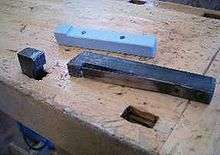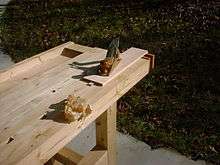Bench dog



A bench dog is an accessory used on a woodworking workbench to allow clamping of wooden items while being worked or planed. Dog in general is something which holds. At its most basic a bench dog is simply a peg which is installed in a corresponding dog hole in the top of a bench. The holes are arranged in a line perpendicular to the vise, perhaps three or four inches apart but certainly no further apart than the fully open distance between the vise's jaws.
There is a matching dog in the vise. Thus the woodworker can place a bench dog into a suitable dog hole and clamp a piece of timber between the bench dog in the bench and the bench dog in the vise.
It is normal to have two rows of holes, with pairs of holes parallel to the vise so that one has four clamping points. Benches that have a tail vise and a face vise might have two sets of bench dog holes so that it is possible to clamp in this way from either vise.
Bench dogs may be square or round. Round dog holes are easier to make as they are simply drilled into the bench using a suitably sized bit. However round dogs do not provide the best gripping surface. Some woodworkers use round dogs which have been flattened on one side to avoid this issue.
Square dog holes may be created using a mortiser or by using a chisel in the same way that a mortise is created. However the most common way to make these holes is to cut a series of dadoes in the edge of one of the boards that will make up the benchtop. When the boards are laminated together to form the benchtop, the dadoes form the square holes that are required.
Bench dogs require some form of friction mechanism to prevent them falling through the dog hole when in use. This may be achieved by the installation of a strip of spring steel or wire on the side of the bench dog, or simply by making the bench dog a tight fit in the hole. There are various commercial dogs available which solve this problem in numerous ways.